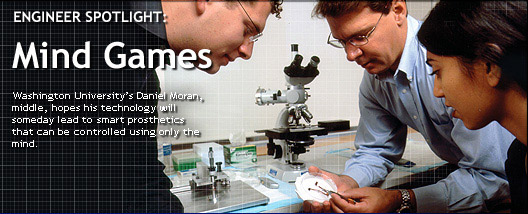Engineer Spotlight: Daniel Moran

“I wanted to do this my whole life,” says Daniel Moran, a biomedical engineering professor at Washington University. As a bright kid growing up in the 1970s, Moran was a devoted fan of “The Six Million Dollar Man”— a TV show about an astronaut who is “rebuilt” with bionics after a serious crash. The show’s opening lines still resonate with him: “Gentlemen, we can rebuild him. We have the technology. We have the capability to make the world’s first bionic man. Steve Austin will be that man. We can make him better than he was. Better. Stronger. Faster.”
Moran isn’t giving anyone arms with the strength of bulldozers or eyeballs equipped with night vision and zoom features, but he is working toward his childhood dream of using technology to mend people with serious injuries. Moran’s latest efforts could prove to be even more impressive than anything the TV writers dreamed up for Steve Austin.
Working in collaboration with neurosurgeon Eric C. Leuthardt, Moran is developing technology that enables people to move objects on a computer screen using only their minds. No joystick. No keyboard. No motion sensors. Just the electrical signals from their brains. In their most recent experiment, Moran and his coworkers were able to get a 14-year-old boy to play the classic arcade game “Space Invaders” with nothing but his imagination.
The teenager was undergoing treatment for epilepsy, which involves surgically placing an electronic grid directly onto the surface of the brain. The patient stays in the hospital for about a week so doctors can monitor the grid for signals in the brain that pinpoint the focus areas of seizures, with the aim of removing that area.
“When patients are undergoing the seizure monitoring, they’re in bed all the time,” Moran says. It can get pretty boring, and that can be a problem because the inactive patients tend to have few seizures, making it more difficult to locate the area of the brain responsible for the seizures.
Moran’s group hit upon a way to help the teen pass the time and also get valuable information at the same time. They were able to interface the monitoring system with the “Space Invaders” software, which they then programmed so that when the teenager made certain movements, those motions would initiate movement in the video game.
Moving his tongue would move the video game’s laser cannon. Wiggling his fingers would make the cannon shoot. Next, they asked the teen to think about those movements, but to not really do them. It wasn’t long before the teenager was playing the game just by thinking about it.
Of course, the goal isn’t to get people to throw out their handheld controllers and play video games with their brains. Rather, Moran thinks the technology could someday help quadriplegics and people with degenerative muscle diseases interface with computers and control wheelchairs with just their minds.
It might even lead to a new generation of smart prosthetics that can be controlled just by thinking about it—not that different from the way people move the limbs they were born with. Shades of “The Six Million Dollar Man” indeed.
FOR MORE INFORMATION:
Filed under: Biomedical, Explore Engineering








